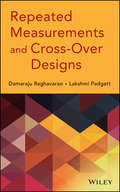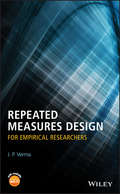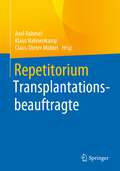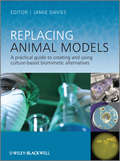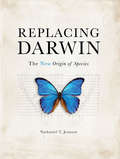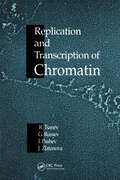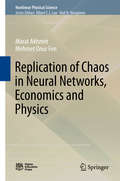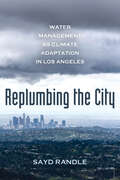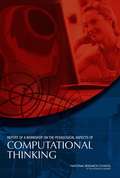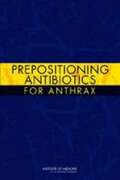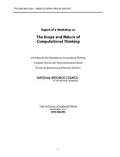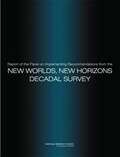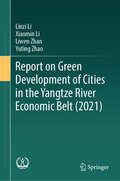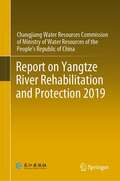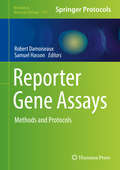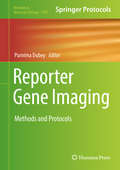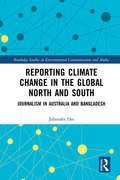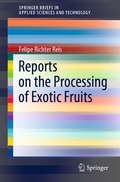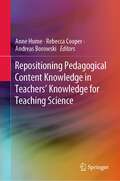- Table View
- List View
Repeated Measurements and Cross-Over Designs
by Lakshmi Padgett Damaraju RaghavaraoAn introduction to state-of-the-art experimental design approaches to better understand and interpret repeated measurement data in cross-over designs.Repeated Measurements and Cross-Over Designs:Features the close tie between the design, analysis, and presentation of resultsPresents principles and rules that apply very generally to most areas of research, such as clinical trials, agricultural investigations, industrial procedures, quality control procedures, and epidemiological studiesIncludes many practical examples, such as PK/PD studies in the pharmaceutical industry, k-sample and one sample repeated measurement designs for psychological studies, and residual effects of different treatments in controlling conditions such as asthma, blood pressure, and diabetes.Utilizes SAS(R) software to draw necessary inferences. All SAS output and data sets are available via the book's related website.This book is ideal for a broad audience including statisticians in pre-clinical research, researchers in psychology, sociology, politics, marketing, and engineering.
Repeated Measures Design for Empirical Researchers
by J. P. VermaThis book focuses on repeated measures designs, and while other books on design of experiments typically only explain the computation involved in each design, this book provides comprehensive solutions to each repeated measures design (RMD) discussed beginning with the formation of research questions to step-by-step analysis using IBM SPSS to the interpretation of the findings. The author uniquely discusses how to conceptualize research problems as well as identify appropriate repeated measures designs for research purposes. Examples have been carefully chosen from a multitude of domains, including psychology, the social sciences, management, and sports science, to aid readers in understanding both the associated theories and methodologies. The book contains eight chapters, the first three of which deal with various fundamental concepts involved in the design of experiments, basic statistical designs, computational details, differentiating independent and repeated measures designs, testing assumptions, and the introduction of SPSS softwar. The remaining chapters address five important repeated measures designs that are frequently used by researchers, namely two-way repeated measures design, two-way mixed design, one-way repeated measures ANOVA, and mixed design with two-way MANOVA.
Repetitorium Transplantationsbeauftragte
by Klaus Hahnenkamp Axel Rahmel Claus-Dieter MiddelKompakt und übersichtlich fasst das Buch die Wissensinhalte zusammen, die Ärzte und Pflegefachpersonal als Transplantationsbeauftragte auf einer Intensivstation benötigen. Es kann als anschauliche Einführung in das Aufgabenfeld ebenso verwendet werden wie als Nachschlagewerk für den erfahrenen Transplantationsbeauftragten. Alle Inhalte des Curriculums der Bundesärztekammer sind berücksichtigt, damit eignet es sich auch als Begleitbuch für die curricularen Kurse. Der inhaltliche Schwerpunkt liegt auf den Fragestellungen, die für die praktische Tätigkeit als Transplantationsbeauftragter besonders wichtig sind, wie die Voraussetzungen für eine Organspende und ihre Durchführung. Doch auch organisatorische, rechtliche und ethische Fragestellungen kommen nicht zu kurz. Die Links zu wichtigen Adressen und Arbeitsmaterialien können über integrierte QR-Codes direkt aufgerufen werden.
Replacing Animal Models
by Jamie DaviesOver the last decade, in vitro models have become more sophisticated and are at a stage where they can provide an effective alternative to in vivo experiments. Replacing Animal Models provides scientists and technicians with a practical, integrated guide to developing culture-based alternatives to in vivo experiments.The book is neither political nor polemical: it is technical, illustrating by example how alternatives can be developed and used and providing useful advice on developing others. After looking at the reasons for and potential benefits of alternatives to animal experiments, the book covers a range of methods and examples emphasising the design considerations that went into each system. The chapters also include 'case studies' that illustrate the ways in which culture models can be used to answer a range of important biological questions of direct relevance to human development, physiology, disease and healing.The thesis of this book is not that all animal experimentation can be replaced, now or in the near future, by equally effective or superior alternatives. Rather, the premise is that there is substantial opportunity, here and now, to do some common types of experiment better in vitro than in vivo, and that doing so will result in both scientific and ethical gains.
Replacing Darwin: The NEW Origin of Species
by Nathaniel T JeansonIf Darwin were to examine the evidence today using modern science, would his conclusions be the same? Charles Darwin’s On the Origin of Species, published over 150 years ago, is considered one of history’s most influential books and continues to serve as the foundation of thought for evolutionary biology. Since Darwin’s time, however, new fields of science have immerged that simply give us better answers to the question of origins. With a Ph.D. in cell and developmental biology from Harvard University, Dr. Nathaniel Jeanson is uniquely qualified to investigate what genetics reveal about origins. The Origins Puzzle Comes Together If the science surrounding origins were a puzzle, Darwin would have had fewer than 15% of the pieces to work with when he developed his theory of evolution. We now have a much greater percentage of the pieces because of modern scientific research. As Dr. Jeanson puts the new pieces together, a whole new picture emerges, giving us a testable, predictive model to explain the origin of species. A New Scientific Revolution Begins Darwin’s theory of evolution may be one of science’s “sacred cows,” but genetics research is proving it wrong. Changing an entrenched narrative, even if it’s wrong, is no easy task. Replacing Darwin asks you to consider the possibility that, based on genetics research, our origins are more easily understood in the context of . . . In the beginning . . . God, with the timeline found in the biblical narrative of Genesis. There is a better answer to the origins debate than what we have been led to believe. Let the revolution begin! About the Author Dr. Nathaniel Jeanson is a scientist and a scholar, trained in one of the most prestigious universities in the world. He earned his B.S. in Molecular Biology and Bioinformatics from the University of Wisconsin-Parkside and his PhD in Cell and Developmental Biology from Harvard University. As an undergraduate, he researched the molecular control of photosynthesis, and his graduate work involved investigating the molecular and physiological control of adult blood stem cells. His findings have been presented at regional and national conferences and have been published in peer-reviewed journals, such as Blood, Nature, and Cell. Since 2009, he has been actively researching the origin of species, both at the Institute for Creation Research and at Answers in Genesis.
Replication and Transcription of Chromatin
by Roumen G. Tsanev George Russev Iliya Pashev Jordanka S. ZlatanovaReplication and Transcription of Chromatin summarizes the main structural features of chromatin and presents results on replication and transcription gained over the last 20 years. The book emphasizes DNA-histone complexes and their importance in restricting genetic information encoded in DNA. Figures are used to illustrate many of the most important concepts of chromatin replication and transcription, and promising hypotheses and models are discussed to promote further research. Replication and Transcription of Chromatin is an important reference for biochemists, biophysicists, molecular biologists, cell biologists, and other researchers interested in this topic.
Replication of Chaos in Neural Networks, Economics and Physics
by Marat Akhmet Mehmet Onur FenThis book presents detailed descriptions of chaos for continuous-time systems. It is the first-ever book to consider chaos as an input for differential and hybrid equations. Chaotic sets and chaotic functions are used as inputs for systems with attractors: equilibrium points, cycles and tori. The findings strongly suggest that chaos theory can proceed from the theory of differential equations to a higher level than previously thought. The approach selected is conducive to the in-depth analysis of different types of chaos. The appearance of deterministic chaos in neural networks, economics and mechanical systems is discussed theoretically and supported by simulations. As such, the book offers a valuable resource for mathematicians, physicists, engineers and economists studying nonlinear chaotic dynamics.
Replumbing the City: Water Management as Climate Adaptation in Los Angeles
by Sayd RandleMoving between shower drains, aqueducts, rain gardens, and even kitchen sinks, Replumbing the City traces the enormous urban waterscape of Los Angeles in a state of flux. For more than a century, the city of Los Angeles has relied on faraway water for the vast majority of its municipal supply, but climate change is making these distant sources much less dependable. To adapt, Angelenos—including city engineers, advocates at NGOs, and residents—are developing new water supplies within the space of the city. Sayd Randle’s ethnography examines the labor of replumbing LA’s sprawling water system, detailing how a desire to sustain unlimited and uninterrupted water provision for paying customers is reshaping the urban environment and its management. Tracking how such projects redistribute the work of water management, the book explores thorny questions of how the labor of climate adaptation should be mobilized and valued.
Report of a Workshop of Pedagogical Aspects of Computational Thinking
by The National Academy of SciencesIn 2008, the Computer and Information Science and Engineering Directorate of the National Science Foundation asked the National Research Council (NRC) to conduct two workshops to explore the nature of computational thinking and its cognitive and educational implications. The first workshop focused on the scope and nature of computational thinking and on articulating what "computational thinking for everyone" might mean. A report of that workshop was released in January 2010. Drawing in part on the proceedings of that workshop, Report of a Workshop of Pedagogical Aspects of Computational Thinking, summarizes the second workshop, which was held February 4-5, 2010, in Washington, D. C. , and focuses on pedagogical considerations for computational thinking. This workshop was structured to gather pedagogical inputs and insights from educators who have addressed computational thinking in their work with K-12 teachers and students. It illuminates different approaches to computational thinking and explores lessons learned and best practices. Individuals with a broad range of perspectives contributed to this report. Since the workshop was not intended to result in a consensus regarding the scope and nature of computational thinking, Report of a Workshop of Pedagogical Aspects of Computational Thinking does not contain findings or recommendations.
Report of a Workshop on Science, Technology, Engineering, and Mathematics (STEM) Workforce Needs for the U.S. Department of Defense and the U.S. Defense Industrial Base
by Technology Committee on Science Engineering Mathematics Workforce Needs for the U.S. Department of Defense the U.S. Defense Industrial Base"Report of a Workshop on Science, Technology, Engineering, and Mathematics (STEM) Workforce Needs for the U. S. Department of Defense and the U. S. Defense Industrial Base" is the summary of a workshop held August 11, 2011, as part of an 18-month study of the issue. This book assesses the STEM capabilities that the Department of Defense (DOD) needs in order to meet its goals, objectives, and priorities; to assess whether the current DOD workforce and strategy will meet those needs; and to identify and evaluate options and recommend strategies that the department could use to help meet its future STEM needs.
Report of a Workshop on the Scope and Nature of Computational Thinking
by National Research Council of the National AcademiesReport of a Workshop on the Scope and Nature of Computational Thinking presents a number of perspectives on the definition and applicability of computational thinking. For example, one idea expressed during the workshop is that computational thinking is a fundamental analytical skill that everyone can use to help solve problems, design systems, and understand human behavior, making it useful in a number of fields. Supporters of this viewpoint believe that computational thinking is comparable to the linguistic, mathematical and logical reasoning taught to all children. Various efforts have been made to introduce K-12 students to the most basic and essential computational concepts and college curricula have tried to provide a basis for life-long learning of increasingly new and advanced computational concepts and technologies. At both ends of this spectrum, however, most efforts have not focused on fundamental concepts. The book discusses what some of those fundamental concepts might be. Report of a Workshop on the Scope and Nature of Computational Thinking explores the idea that as the use of computational devices is becoming increasingly widespread, computational thinking skills should be promulgated more broadly. The book is an excellent resource for professionals in a wide range of fields including educators and scientists.
Report of the Committee on Proposal Evaluation for Allocation of Supercomputing Time for the Study of Molecular Dynamics: Second Round
by Board on Life SciencesThe Committee on Proposal Evaluation for Allocation of Supercomputing Time for the Study of Molecular Dynamics evaluated submissions received in response to a Request for Proposals (RFP) for Biomolecular Simulation Time on Anton, a supercomputer specially designed and built by D.E. Shaw Research (DESRES) that allows for dramatically increased molecular dynamics simulations compared to other currently available resources. Over the past year (October 1, 2010 -- September 30, 2011), DESRES has made available to the non-commercial research community 3,000,000 node-hours on an Anton system housed at the Pittsburgh Supercomputing Center (PSC), based on the advice of a previous National Research Council committee convened in the fall of 2010. The goal of the second RFP for Biomolecular Simulation Time on Anton has been to continue to facilitate breakthrough research in the study of biomolecular systems by providing a massively parallel system specially designed for molecular dynamics simulations. These special capabilities allow multi-microsecond to millisecond simulation timescales, which previously had been unobtainable. The program seeks to continue to support research that addresses important and high impact questions demonstrating a clear need for Anton's special capabilities. The Anton RFP described the three criteria against which the committee was asked to evaluate proposals: Scientific Merit, Justification for Requested Time Allocation, and Investigator Qualifications and Past Accomplishments.
Report of the Committee on Proposal Evaluation for Allocation of Supercomputing Time for the Study of Molecular Dynamics: Third Round
by National Research Council of the National AcademiesThe committee evaluated submissions received in response to a request for proposals (RFP) for Biomolecular Simulation Time on Anton, a supercomputer specially designed and built by D.E. Shaw Research (DESRES) that allows for dramatically increased molecular dynamics simulations compared to other currently available resources. During the past 2 years, DESRES has made available to the non-commercial research community node-hours on an Anton system housed at the Pittsburgh Supercomputing Center (PSC), based on the advice of previous National Research Council committees convened in the falls of 2010 and 2011.
Report of the Panel on Implementing Recommendations from the New Worlds, New Horizons Decadal Survey
by Panel on Implementing Recommendations from New Worlds New Horizons Decadal SurveyThe 2010 Astronomy and Astrophysics Decadal Survey report, "New Worlds, New Horizons in Astronomy and Astrophysics" (NWNH), outlines a scientifically exciting and programmatically integrated plan for both ground- and space-based astronomy and astrophysics in the 2012-2021 decade. However, late in the survey process, the budgetary outlook shifted downward considerably from the guidance that NASA had provided to the decadal survey. And since August 2010--when NWNH was released--the projections of funds available for new NASA Astrophysics initiatives has decreased even further because of the recently reported delay in the launch of the James Webb Space Telescope (JWST) to no earlier than the fourth quarter of 2015 and the associated additional costs of at least $1. 4 billion. These developments jeopardize the implementation of the carefully designed program of activities proposed in NWNH. In response to these circumstances, NASA has proposed that the United States consider a commitment to the European Space Agency (ESA) Euclid mission at a level of approximately 20 percent. This participation would be undertaken in addition to initiating the planning for the survey's highest-ranked, space-based, large-scale mission, the Wide-Field Infrared Survey Telescope (WFIRST). The Office of Science and Technology Policy (OSTP) requested that the National Research Council (NRC) convene a panel to consider whether NASA's Euclid proposal is consistent with achieving the priorities, goals, and recommendations, and with pursuing the science strategy, articulated in NWNH. The panel also investigated what impact such participation might have on the prospects for the timely realization of the WFIRST mission and other activities recommended by NWNH in view of the projected budgetary situation. The panel convened a workshop on November 7, 2010. The workshop presentations identified several tradeoffs among options: funding goals less likely versus more likely to be achieved in a time of restricted budgets; narrower versus broader scientific goals; and U. S. -only versus U. S. -ESA collaboration. The panel captured these tradeoffs in considering four primary options: Option A: Launch of WFIRST in the Decade 2012-2021; Option B: A Joint WFIRST/Euclid Mission; Option C: Commitment by NASA of 20 percent Investment in Euclid prior to the M-class decision; or Option D: No U. S. Financing of an Infrared Survey Mission This Decade.
Report of the Treasurer of the National Academy of Sciences
by National Academy of Science the National AcademiesThis Report of the Treasurer of the National Academy of Sciences presents the financial position and results of operations, as well as a review of the endowment, trust, and other long-term investments pool activities of the Academy for the year ended December 31, 2008.
Report of the Treasurer of the National Academy of Sciences
by National Academy of Sciences of the National AcademiesThis Report of the Treasurer of the National Academy of Sciences presents the financial position and results of operations, as well as a review of the endowment, trust, and other long-term investments pool activities of the Academy for the year ended December 31, 2009.
Report of the Treasurer of the National Academy of Sciences for the Year Ended December 31, 2015
by Engineering Medicine National Academies of SciencesThe income that supports the activities of the National Academy of Sciences (NAS) comes from two major sources: program revenue received from sponsors to pay for the myriad studies and other activities undertaken each year by the National Academies of Sciences, Engineering, and Medicine, and a much smaller sum that is obtained from our endowment under the endowment spending policies adopted by the Council. The goal of the endowment is to provide stable support for the Academy’s programs and activities. To achieve this goal, the Council, acting on the recommendations of the Finance Committee, has historically authorized spending from the portfolio at a rate designed to maintain the purchasing power of the endowment over time. This Report of the Treasure of the National Academy of Sciences presents the financial position and results of operations as well as a review of the endowment, trust, and other long-term investments portfolio activities of our Academy for the year ended December 31, 2015. While this book provides essential financial summary to key personnel, it also serves as a vital informative resource for various members of the public, private, and governmental sectors.
Report on Green Development of Cities in the Yangtze River Economic Belt (2021)
by Yuting Zhao Linzi Li Xiaomin Li Liwen ZhanThe report aims to help the cities in the Yangtze River Economic Belt of China identify their potentials for green development, especially to find their own suitable green development paths. Based on the evaluation, six green development models that can be replicated and promoted are initially established by selecting typical cities as pilot. The report is the first volume of its series and will be updated annually with more abundant green development models.
Report on Yangtze River Rehabilitation and Protection 2019
by CWRCThis book summarizes the achievements and experience of the Yangtze River rehabilitation and protection, analyzes the new situation and requirements of the Yangtze River rehabilitation and protection, and discusses the main issues and their solution alternatives for the Yangtze River rehabilitation and protection efforts. The Yangtze River, respected as the mother river of the Chinese nation, contributes immensely toward the socioeconomic development of China and braces up the national strategies such as the development of the Yangtze River Economic Belt and the integrated development of the Yangtze River Delta, etc. Whether the Yangtze River is under good stewardship has implications on not only the wellbeing of more than 400 million inhabitants in the basin, but also in broader sense the overall sustainability of socioeconomic development of the whole country. This book which has two parts, provides a multidirectional analysis of Yangtze River rehabilitation and protection. The first part explores the stages, achievements, and the future of the Yangtze rehabilitation and protection. Major issues existing in Yangtze River Basin rehabilitation and protection are discussed in the second part. Many pictures, charts, and diagrams are involved providing an understanding of the situation of Yangtze River Basin.
Reporter Gene Assays: Methods And Protocols (Methods In Molecular Biology #1755)
by Robert Damoiseaux Samuel HassonThis volume explores the applications of reporter gene technology and the methodologies needed for their effective implementation. The chapters in this book cover practical topics such as how to integrate reporter constructs into cellular models, viral delivery, splicing applications, in vivo imaging, and a guide to the use of multi-cistronic constructs. Additionally, chapters also include detailed mechanistic uses of reporter genes in cellular pathways, and a look at project and data management of screening applications. Written in the highly successful Methods in Molecular Biology series format, chapters include introductions to their respective topics, lists of the necessary materials and reagents, step-by-step, readily reproducible laboratory protocols, and tips on troubleshooting and avoiding known pitfalls.Cutting-edge and thorough, Reporter Gene Assays: Methods and Protocols is a valuable resource for anyone who is interested in learning more about reporter genes.
Reporter Gene Imaging: Methods and Protocols (Methods in Molecular Biology #1790)
by Purnima DubeyThis volume provides an introduction for the scientist who is new to the field of molecular imaging, as well as detailed methods for experts in other areas of molecular imaging. Chapters detail the advantages and limitations of combining fluorescent, bioluminescent and radioisotopic, creating dual modality imaging reporter gene construct, bioluminescent imaging, and bioluminescent or fluorescent imaging. Written in the highly successful Methods in Molecular Biology series format, chapters include introductions to their respective topics, lists of the necessary materials and reagents, step-by-step, readily reproducible laboratory protocols, and tips on troubleshooting and avoiding known pitfalls. Authoritative and practical, Reporter Gene Imaging : Methods and Protocols aims to ensure successful results in the further study of this vital field.
Reporting Climate Change in the Global North and South: Journalism in Australia and Bangladesh (Routledge Studies in Environmental Communication and Media)
by Jahnnabi DasThis book reveals how journalists in the Global North and Global South mediate climate change by examining journalism and reporting in Australia and Bangladesh. This dual analysis presents a unique opportunity to examine the impacts of media and communication in two contrasting countries (in terms of economy, income and population size) which both face serious climate change challenges. In reporting on these challenges, journalism as a political, institutional, and cultural practice has a significant role to play. It is influential in building public knowledge and contributes to knowledge production and dialogue, however, the question of who gets to speak and who doesn’t, is a significant determinant of journalists’ capacity to establish authority and assign cultural meaning to realities. By measuring the visibility from presences and absences, the book explores the extent to which the influences are similar or different in the two countries, contrasting how journalists’ communication power conditions public thought on climate change. The investigation of climate communication across the North-South divide is especially urgent given the global commitment to reduce greenhouse gas emissions and it is critical we gain a fuller understanding of the dynamics of climate communication in low-emitting, low-income countries as much as in the high emitters, high-income countries. This book contributes to this understanding and highlights the value of a dual analysis in being ably draw out parallels, as well as divergences, which will directly assist in developing cross-national strategies to help address the mounting challenge of climate change. This book will be of great interest to students and scholars of climate change and environmental journalism, as well as media and communication studies more broadly.
Reporting Research
by R. S. ClymoWant to learn how to present your research successfully? This practical guide for students and postdoctoral scholars offers a unique step-by-step approach to help you avoid the worst, yet most common, mistakes in biology communication. Covering irritants such as sins of ambiguity, circumlocution, inconsistency, vagueness and verbosity, misuse of words and quantitative matters, it also provides guidance to design your next piece of work effectively. Learn how to write scientific articles and get them published, prepare posters and talks that will capture your audience and develop a critical attitude towards your own work as well as that of your colleagues. With numerous practical examples, comparisons among disciplines, valuable tips and real-life anecdotes, this must-read guide will be a valuable resource to both new graduate students and their supervisors.
Reports on the Processing of Exotic Fruits (SpringerBriefs in Applied Sciences and Technology)
by Felipe Richter ReisThis book presents exotic fruit processing as a way to obtaining traditional and innovative fruit products by means of various food processing technologies. Built on the basis of specific, up-to-date and reliable scientific reports, it is a unique document for instructing researchers, processors and enthusiasts in the field of exotic fruit processing.
Repositioning Pedagogical Content Knowledge in Teachers’ Knowledge for Teaching Science
by Anne Hume Rebecca Cooper Andreas BorowskiThis book enhances readers’ understanding of science teachers’ professional knowledge, and illustrates how the Pedagogical Content Knowledge research agenda can make a difference in teachers’ practices and how students learn science. Importantly, it offers an updated international perspective on the evolving nature of Pedagogical Content Knowledge and how it is shaping research and teacher education agendas for science teaching. The first few chapters background and introduce a new model known as the Refined Consensus Model (RCM) of Pedagogical Content Knowledge (PCK) in science education, and clarify and demonstrate its use in research and teacher education and practice. Subsequent chapters show how this new consensus model of PCK in science education is strongly connected with empirical data of varying nature, contains a tailored language to describe the nature of PCK in science education, and can be used as a framework for illuminating past studies and informing the design of future PCK studies in science education. By presenting and discussing the RCM of PCK within a variety of science education contexts, the book makes the model significantly more applicable to teachers’ work.
